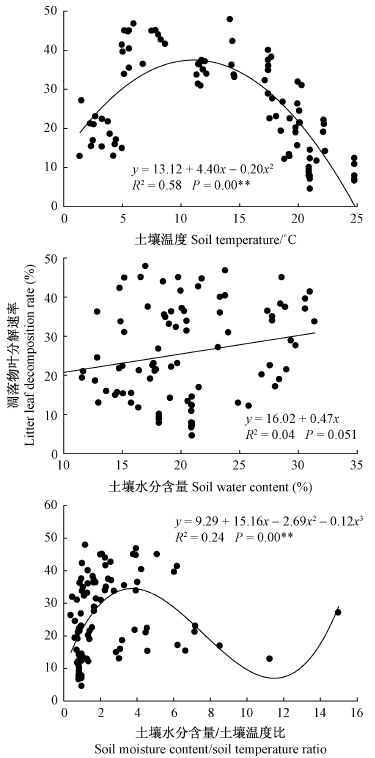文章信息
- 葛晓改, 曾立雄, 黄志霖, 肖文发, 谭本旺, 周本智
- Ge Xiaogai, Zeng Lixiong, Huang Zhilin, Xiao Wenfa, Tan Benwang, Zhou Benzhi
- 土壤温度和水分含量对三峡库区马尾松林凋落物叶分解的影响
- Effects of Soil Temperature and Soil Water Content to Needle Litter Leaf Decomposition of Pinus massoniana Plantations in Three Gorges Reservoir Area
- 林业科学, 2013, 49(9): 153-157
- Scientia Silvae Sinicae, 2013, 49(9): 153-157.
- DOI: 10.11707/j.1001-7488.20130922
-
文章历史
- 收稿日期:2012-07-09
- 修回日期:2013-07-11
-
作者相关文章
2. 中国林业科学研究院亚热带林业研究所 富阳 311400;
3. 湖北省秭归县林业局 姊归 443631
2. Research Institute of Subtropical Forestry, CAF Fuyang 311400;
3. Forestry Bureau of Zigui County of Hubei Province Zigui 443631
凋落物是一个重要的有机质和养分储存库,是陆地生态系统养分循环的重要环节,是维系植物体地上碳库与土壤碳库循环的主要通道之一(Raich et al.,1989; 徐小锋等,2007)。凋落物分解过程受基质质量、土壤动物、环境因素(土壤温度和湿度)和土壤养分供应的影响(McClaugherty et al.,1985; Raich et al.,2007)。土壤温度和土壤水分含量可直接和间接地影响凋落物的分解过程(Vitousek,1984; Boyero et al.,2011),即通过凋落物分解过程的淋溶作用和微生物活性直接地影响凋落物的分解(李志安等,2004),通过凋落物基质质量间接地影响凋落物的分解(Swift et al.,1979; Hobbie et al.,2000)。温度是凋落物分解过程中主要的决定因子之一,Fierer等(2005)开展凋落物基质质量分解对温度敏感性的影响研究表明,凋落物分解时顽固复合物含量多的比含量少的温度敏感度高; 如果Q10(温度增加10 ℃将导致增加的分解速率)增加25%,北方森林土壤净碳通量将增加200%。土壤水分主要通过分解者的活动影响凋落物分解和养分释放,降雨量则影响凋落物的淋溶和破碎(Swift et al.,1979),为分解者提供有效碳和养分而显著影响分解速率,使凋落物中的木质素和养分含量随降雨量的不同而变化(Austin et al.,2000)。降雨量对凋落物分解的间接影响研究表明降雨量对凋落物叶分解及养分释放模式影响明显(Austin et al.,2000;李雪峰等,2007),但土壤温度和土壤水分含量对凋落物叶分解综合影响的量化及凋落物叶基质质量对分解的间接影响国内报道较少。
马尾松(Pinus massoniana)主要分布在我国亚热带地区,主要分布在南方15个省区(杨会侠等,2010),松林面积约200万hm2,居全国针叶林首位。马尾松适应性强,耐干旱与瘠薄,是三峡库区典型造林树种之一(肖文发等,2000)。马尾松林凋落物主要由凋落物叶、枝、树皮、繁殖器官和杂物组成,其中,凋落物叶为主要组分,占总量的61.6%~84.5%(杨会侠等,2010); 马尾松林凋落物中叶的比重大且分解相对较快,一定程度上反映凋落物养分归还的速率。本研究以三峡库区马尾松林凋落物叶为研究对象,分析不同立地条件下马尾松林土壤温度和土壤水分含量对凋落物叶分解的影响,为凋落物叶分解对气候变化响应的研究奠定基础,为揭示三峡库区森林生态系统养分循环机制提供依据。
1 研究区概况三峡库区东起湖北宜昌,西至重庆江津,全长约600 km,为跨长江两岸数公里的狭长区域(106°14'—111°28' E,28°56'—31°44' N)。三峡库区总面积5.8万km2,地处亚热带北缘,气候属亚热带大陆性季风气候,温暖湿润,四季分明,光照水热充足。年均气温17~19 ℃,年降水量1 000~1 250 mm,降水集中在4—9月,空气相对湿度较大,可达60%~80%(陈鲜艳等,2009)。土壤以红、黄壤为主,同时还有较大面积的紫色土和石灰土(肖文发等,2000)。三峡库区自然环境优越,具有我国东西与南北生物界过渡的特点,亚热带至温带物种极为丰富,植被类型多样。但由于过渡开发,自然植被破坏严重,现有植被为残次林和人工林。研究区域内主要树种为马尾松、柏木(Cupressus funebris)、杉木(Cunninghamia lanceolata)和华山松(Pinus arm and i)(程瑞梅等,2008; 王鹏程等,2009)。
本研究以秭归县境内20,30和46年生马尾松人工林凋落物叶为研究对象,其中,20和46年生林分位于茅坪镇罗家林场(110°55' E,30°47' N),30年生林分位于茅坪镇兰陵村(110°54' E,30°52' N),林下灌木多为油茶(Camellia oleifera)、檵木(Loropetalum chinense)和毛黄栌(Cotinus coggygria)等,草本多为稗草(Echinochloa crusgalli)和腹水草(Veronicastrum axillare)等(葛晓改等,2012),林分概况见表 1。
|
|
于2010年4月在秭归县境内20,30和46年生马尾松人工林中各设置3块20 m×30 m样地用于凋落物分解试验。2010年5—7月,在3种马尾松人工林中分别收集新自然凋落、未分解的针叶,同一林地收集的凋落物叶充分混合,风干后称取凋落物叶15 g,直接装入大小为20 cm×20 cm、孔径1 mm的尼龙网袋中。于2010年7月底将分解袋分别放置于3种马尾松林下,放置分解袋前进行凋落物清理,使分解袋紧贴地面,让凋落物叶自然分解,之后每月底对分解袋上的新凋落物进行清理。每种马尾松林地放置90袋,即每块样地中随机放置30袋,3种林分共270袋。同时,称取3种风干的凋落物叶各15 g,在80 ℃下烘干至恒质量,算出风干与烘干质量转换系数,3次重复。自放置日期起,每3个月每林分随机取回15袋(每样地5袋),共取6次; 清除凋落物叶分解袋内侵入的根系、泥沙,烘至恒质量,并计算干质量剩余率和分解速率。相同样地的凋落物分解袋测干质量后合并为一个样,并进行凋落物叶基质质量和养分测定。
2.2 土壤温度和水分含量测定在每种马尾松林中具有代表性的样地中放置EM50自计数据采集器(Decagon,USA)各1套,数据采集器包含5温度、5湿度探头,温度、水分含量探头埋置5 cm深处; 用于自动采集土壤5 cm深处温度和水分含量数据,每1 h记录1次; 自2010年7月底至2012年1月每3个月取1次数据。
2.3 数据处理与统计分析马尾松凋落物叶分解干质量剩余率(%)计算公式如下(Swift et al.,1979):
$R = 100\%k\left({{M_t}/{M_0}} \right)。$
式中: k为凋落物风干样品与烘干样品转换系数,Mt为凋落物t时间烘干样品质量,M0为凋落物起始风干样品质量。
凋落物叶分解率L计算公式如下(Swift et al.,1979):
$L = 100\% - R。$
凋落物叶干质量剩余率变化用Olson负指数衰减模型进行拟合(Olson,1963):
$R = a{{\rm{e}}^{ - kt}}。$
式中: a为拟合参数; k为年分解系数(kg·kg-1a-1); t为时间(a)。
采用SigmaPlot 12.0和SPSS 16.0软件进行数据统计分析和做图。分解速率和土壤温度、土壤水分含量间的显著性检验采用单因子方差分析(ANOVA)的最小显著差异法(LSD),显著性水平设定为α=0.05; 马尾松林凋落物叶分解速率与土壤温度、土壤水分含量关系采用回归分析法。
3 结果与分析 3.1 土壤温度和水分含量变化30年生马尾松林土壤温度和水分含量与20和46年生差异显著(图 1)。20,30和46年生林分年平均土壤温度分别为12.90,15.43和12.75 ℃; 30年生林分分别比20和46年生年平均温度分别高2.53和2.68 ℃; 20,30和46年生林分年平均土壤水分含量分别为22.48%,15.59%和21.89%,30年生林分水分含量比20年生和46年生林分分别低6.89%和6.30%。
 |
图 1 马尾松林土壤温度和水分含量动态
Fig. 1 Dynamic of soil temperature and moisture content in P. massoniana stands
|
3种林分土壤温度和水分含量月动态差异显著(图 1)。3种林分土壤温度变化模式类似,均是1月份最低,7月份最高; 1月份土壤温度表现为46年生(2.07 ℃)<20年生(2.49 ℃)<30年生(4.09 ℃),7月份土壤温度表现为46年生(21.82 ℃)<20年生(22.01 ℃)<30年生(24.20 ℃)。3种林分土壤水分含量变化不同: 20年生林分表现为1月最低(19.07%),8月份最高(24.24%); 30年生林分表现为9月份最低(12.86%),12月份最高(18.49%); 46年生林分则表现为5月份最低(16.59%),12月份最高(26.26%)。
3.2 凋落物叶分解动态马尾松林凋落物叶经过540天分解,20年生林分凋落物叶分解干质量剩余率是63.57%,30年生是59.80%,46年生是65.50%; 预测的干质量剩余率分别是64.88%,61.07%和64.49%。30年生林分分解速率与20,30年生林分差异显著,分解模式类似(图 2)。0~90天分解比90~180天分解快; 凋落物在2011年180~270天(2—4月)分解最慢,凋落物叶分解在夏季分解最快(即分解的第9~12月)。20,30和46年生马尾松林年凋落物叶分解常数分别是0.29,0.33和0.30,20,30和46年生马尾松林凋落物叶分解50%和95%的时间分别是2.4和10.36年,2.11和9.15年,2.35和10.07年(表 2)。
 |
图 2 凋落叶分解动态
Fig. 2 Litter leaf decomposition dynamic
|
|
|
凋落物叶分解速率与土壤温度、土壤水分含量/土壤温度比关系紧密,与土壤水分含量关系不明显(图 3)。凋落物叶分解速率与土壤温度呈二次函数关系(P<0.01); 土壤水分含量与凋落物叶分解关系不明显(P>0.05); 马尾松林土壤水分含量/土壤温度比与凋落物叶的分解速率呈三次函数关系(图 3),20年生林分土壤水分含量/土壤温度比为0.91~14.99,30年生林分土壤水分含量/土壤温度比为0.49~4.57,46年生林分土壤水分含量/土壤温度比为0.63~11.25。土壤水分含量/土壤温度比在0~4.0时,凋落物叶分解速率随比值增大而增大,在4.0~12.0时凋落物叶分解速率随比值增大而减小。
 |
图 3 凋落物叶分解速率与土壤温度和水分含量的关系
Fig. 3 Relationships between litter leaf decomposition rate and soil temperature,moisture content
|
温度升高促进土壤养分矿化和提高微生物活性进而加快凋落物分解(Fierer et al.,2005)。Cortez(1998)研究表明温度降低会减慢凋落物叶分解。本研究中30年生马尾松林凋落物叶分解速率较20和46年生林分快,这与30年生林分土壤年均温度比20和46年生分别高2.53和2.68 ℃一致,说明凋落物叶分解速率与土壤温度呈正比。
在自然条件下很难分清温度和湿度的单独作用,土壤温度和水分含量在凋落物分解过程中相互作用,很难区分二者的作用(汪思龙等,2010)。本研究中土壤温度和水分含量对凋落物叶分解的综合影响较显著,凋落物叶分解速率与土壤水分含量/温度比呈极显著三次函数关系,这与Cortez(1998)的研究结果不太一致,即土壤水分含量/温度比值和凋落物分解速率关系紧密且呈二次函数关系(y=ax2+bx+c)。
有研究表明凋落物分解速率与年均气温和降雨量显著相关(Moore et al.,1999; Trofymow et al.,2002)。Austin等(2000)研究表明凋落物叶原位分解速率随着降雨的增加而增加。李雪峰等(2007)研究表明降水量变化会显著影响蒙古栎(Quercus mongolica)叶片分解速率和养分释放。Liao等(2006)研究表明降雨对凋落物分解速率的影响比大气温度大。Austin等(1998)研究表明随海拔升高,气温降低,凋落物叶分解速率呈指数降低。本研究3种林分处于同一区域,降雨量差异不大,20和46年生林分海拔比30年生高,气温比30年生稍低,这也是30年生凋落物叶分解速率相对较高的一个原因。
| [1] |
陈鲜艳, 张强, 叶殿秀, 等. 2009. 三峡库区局地气候变化. 长江流域资源与环境, 18(1): 47-51.( 1) 1)
|
| [2] |
程瑞梅, 肖文发. 2008. 三峡库区森林植物群落数量分类与排序. 林业科学, 44(4): 20-27.( 1) 1)
|
| [3] |
葛晓改, 肖文发, 曾立雄, 等. 2012. 不同林龄马尾松凋落物基质质量与土壤养分的关系. 生态学报, 32(3): 852-862.( 1) 1)
|
| [4] |
李雪峰, 韩士杰, 张岩. 2007. 降水量变化对蒙古栎落叶分解过程的间接影响. 应用生态学报, 18(2): 261-266.( 2) 2)
|
| [5] |
李志安, 邹碧, 丁永祯, 等. 2004. 森林凋落物分解重要影响因子及其研究进展. 生态学杂志, 23(6): 77-83.( 1) 1)
|
| [6] |
王鹏程, 姚婧, 肖文发, 等. 2009. 三峡库区森林植被分布的地形分异特征. 长江流域资源与环境, 18(6): 528-534.( 1) 1)
|
| [7] |
汪思龙, 陈楚莹. 2010. 森林残落物生态学. 北京: 科学出版社.( 1) 1)
|
| [8] |
肖文发, 李建文, 于长青, 等. 2000. 长江三峡库区陆生动植物生态. 重庆: 西南师范大学出版社.( 2) 2)
|
| [9] |
徐小锋, 田汉勤, 万师强. 2007. 气候变暖对陆地生态系统碳循环的影响. 植物生态学报, 31(2): 175-188.( 1) 1)
|
| [10] |
杨会侠, 汪思龙, 范冰, 等. 2010. 不同林龄马尾松人工林年凋落物量与养分归还动态. 生态学杂志, 29(12): 2334-2340.( 2) 2)
|
| [11] |
Austin A T, Vitousek P M. 2000. Precipitation, decomposition and litter decomposability of Metrosideros polymorpha in native forests on Hawai's. Journal of Ecology, 88(1): 129-138.( 2) 2)
|
| [12] |
Austin A T, Vitousek P M. 1998. Nutrient dynamics on a precipitation gradient in Hawai'i. Oecologia, 113(4): 519-529.( 1) 1)
|
| [13] |
Bokhorst S, Bjerke J W, Melillo J, et al. 2010. Impacts of extreme winter warming events on litter decomposition in a sub-Arctic heathland. Soil Biology and Biochemistry, 42(4): 611-617.( 1) 1)
|
| [14] |
Boyero L, Pearson R G, Gessner M O, et al. 2011. A global experiment suggests climate warming will not accelerate litter decomposition in streams but might reduce carbon sequestration. Ecology letter, 14(3): 289-294.( 1) 1)
|
| [15] |
Cortez J. 1998. Field decomposition of leaf litters: relationship between decomposition rates and soil moisture, soil temperature and earthworm activity. Soil Biology and Biochemistry, 30(6): 783-793.( 2) 2)
|
| [16] |
Fierer N, Craine J M, Mclauchlan K, et al. 2005. Litter quality and the temperature sensitivity of decomposition. Ecology, 86(2): 320-326.( 2) 2)
|
| [17] |
Hobbie S E, Vrrousek P M. 2000. Nutrient limitation of decomposition in Hawaiian forests. Ecology, 81(7): 1867-1877.( 1) 1)
|
| [18] |
Liao J H, Wang H H, Tsai C C, et al. 2006. Litter production, decomposition and nutrient return of uplifted coral reef tropical forest. Forest Ecology and Management, 235(1-3): 174-185.( 1) 1)
|
| [19] |
McClaugherty C A, Pastor J, Aber J D, et al. 1985. Forest litter decomposition in relation to soil nitrogen dynamics and litter quality. Ecology, 66(1): 266-275.( 1) 1)
|
| [20] |
Moore T R, Trofymow J A, Taylor B, et al. 1999. Litter decomposition rates in Canadian forests. Global Change Biology, 5(1): 75-82.( 1) 1)
|
| [21] |
Olson J S. 1963. Energy storage and the balance of producers and decomposers in ecological systems. Ecology, 44(2): 322-331.( 1) 1)
|
| [22] |
Raich J W, Nadelhoffer K J. 1989. Belowground carbon allocation in forest ecosystems: global trends. Ecology, 70(5): 1346-1354.( 1) 1)
|
| [23] |
Raich J W, Russell A E, Bedoya-Arrieta R. 2007. Lignin and enhanced litter turnover in tree plantations of lowland Costa Rica. Forest Ecology and Management, 239(1-3): 128-135.( 1) 1)
|
| [24] |
Swift M J, Heal O W, Anderson J M. 1979. Decomposition in terrestrial ecosystems. Berkeley: University of California Press.( 4) 4)
|
| [25] |
Trofymow J A, Moore T R, Titus B, et al. 2002. Rates of litter decomposition over 6 years in Canadian forests: influence of litter quality and climate. Canada Journal Forestry Researches, 32(5): 789-804.( 1) 1)
|
| [26] |
Vitousek P M. 1984. Litterfall, nutrient cycling, and nutrient limitation in tropical forests. Ecology, 65(1): 285-298.( 1) 1)
|
 2013, Vol. 49
2013, Vol. 49

